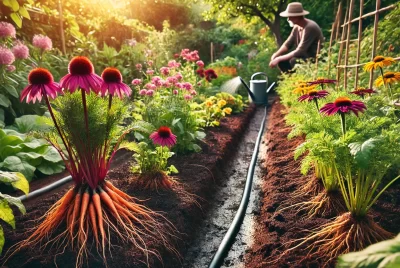Best Vegetables for Hydroponics: A Comprehensive Guide
Introduction
In this guide, we’ll dive into the best vegetables for hydroponics, discuss the key benefits and challenges you might encounter, and ensure you have all the knowledge you need to get started.
Understanding Hydroponics
The Basics of Hydroponic Systems
First things first, let’s talk about what hydroponics really is. At its core, hydroponics is a method of growing plants in a water-based, nutrient-rich solution. It’s a soil-less form of gardening where plants are supported using various mediums like rock wool, clay pellets, or peat moss. The roots of the plants directly contact the nutrient solution, while also having access to oxygen, which is crucial for growth.
Advantages of Hydroponic Farming
Now, you might be wondering, “Why choose hydroponics over traditional gardening?” The advantages are numerous! Hydroponic systems allow for faster plant growth, greater yields, and the ability to grow plants in smaller spaces. They’re also fantastic for the environment, as they use significantly less water than soil-based gardening. Plus, you can forget about the back-breaking work of tilling soil, weeding, and fighting soil-borne pests and diseases.
Selecting the Best Vegetables for Hydroponics
Criteria for Choosing Vegetables
When it comes to selecting the right vegetables for your hydroponic garden, there are a few things to consider. You’ll want to think about the nutritional needs of each plant, their growth patterns, and how these factors align with the specifics of your hydroponic system. Some vegetables thrive in hydroponic environments, while others might require a bit more care and attention.
Nutritional Needs
Each vegetable has its own unique set of nutritional needs. In hydroponics, you have the ability to tailor the nutrient solution to meet these needs precisely. This means you can often grow healthier and more nutrient-rich vegetables compared to traditional gardening.
Growth Patterns
Understanding the growth patterns of different vegetables can greatly impact your success. Some plants, like lettuce and herbs, have relatively short growth cycles and are relatively easy to manage. Others, like tomatoes or cucumbers, might need more space and support as they grow.
Best Vegetables for Hydroponics
Leafy Greens
Lettuce
Lettuce is a superstar in the world of hydroponics. It grows quickly, doesn’t need a lot of light, and you can harvest it just a few weeks after planting. Plus, there’s a wide variety of lettuce types you can experiment with, from crisp romaine to tender butterhead.
Varieties of Lettuce for Hydroponics
When picking lettuce varieties for your hydroponic system, consider trying a mix. Loose-leaf varieties, like oak leaf or red leaf, are great for beginners due to their ease of growth and continuous harvest.
Growing Tips for Hydroponic Lettuce
Keep your nutrient solution well-balanced and ensure your lettuce gets enough light, but not too much heat. Lettuce prefers cooler temperatures, so maintaining a cool environment will lead to crisper, tastier leaves.
Spinach
Spinach is another excellent choice for hydroponic gardens. It’s packed with nutrients and grows fairly quickly. Plus, it’s versatile in the kitchen, making it a favorite for many gardeners.
Benefits of Growing Spinach Hydroponically
Hydroponic spinach is less prone to pests and soil-borne diseases, and you can harvest it repeatedly by picking the outer leaves and allowing the inner ones to continue growing.
Key Considerations for Spinach
Spinach loves light and nutrients but keep an eye on the temperature. Too much heat and your spinach might bolt, which means it’ll start to produce seeds and the leaves will turn bitter.
Herbs
Herbs are some of the most rewarding plants to grow hydroponically. They require little space, grow quickly, and their flavors can be more intense compared to soil-grown counterparts.
Basil
Basil, a favorite in many kitchens, thrives in hydroponic systems. Its fast growth and lush leaves make it an ideal choice.
Ideal Conditions for Hydroponic Basil
Basil loves warmth and plenty of light. Aim for a temperature between 65-75°F and provide at least 10-11 hours of light daily. Keep the nutrient solution pH around 5.5 to 6.5 for optimal growth.
Harvesting and Usage Tips
Harvest basil regularly to encourage bushier growth. Simply snip off the top leaves, leaving enough for the plant to continue growing. Use fresh basil in salads, pesto, or as a delicious garnish.
Cilantro
Cilantro, with its unique flavor, is another great option for hydroponic gardening. It’s a bit more sensitive than basil but well worth the effort.
Growing Cilantro in Hydroponic Systems
Cilantro prefers cooler temperatures and moderate light. Aim for temperatures around 50-70°F. It can be a bit finicky about its nutrient levels, so monitor your solution closely.
Common Challenges and Solutions
Cilantro can bolt (flower prematurely) if stressed by heat or light. If you see signs of bolting, harvest immediately, as the leaves will lose their flavor once the plant flowers.
Cruciferous Vegetables
These vegetables are not only nutritious but also do well in hydroponic systems. Let’s explore a couple of popular choices.
Kale
Kale is a nutrient powerhouse and adapts well to hydroponic cultivation.
Kale Varieties Suitable for Hydroponics
Curly kale and dinosaur kale are great choices for hydroponic systems. They are hardy and can grow in cooler temperatures.
Nutrient Requirements and Growth Tips
Kale benefits from a nutrient solution high in nitrogen. Ensure good air circulation around the plants to prevent fungal diseases. Kale can tolerate cooler temperatures, which can actually make the leaves sweeter.
Broccoli
Broccoli is known for its health benefits and can be grown hydroponically with some care.
The Viability of Broccoli in Hydroponics
Broccoli requires a bit more space and a stable nutrient solution. It’s a heavier feeder, so ensure your nutrient mix is up to the task.
Step-by-Step Guide to Growing Broccoli
Start with high-quality seeds or seedlings. Maintain a nutrient solution pH of 6.0 to 6.8. Broccoli prefers cooler temperatures, around 60-70°F. Watch for pests like aphids and caterpillars, which can be managed with organic insecticides.
Advanced Techniques for the Best Vegetables for Hydroponics
Now that we’ve covered some of the best vegetables for hydroponic systems, let’s delve into some advanced techniques to maximize your success.
Optimizing Nutrient Solutions
Each plant has its unique nutrient needs. Tailoring your nutrient solution to your specific plants can significantly improve growth and yield. Regularly test your solution and adjust as needed.
Tailoring Nutrients for Specific Vegetables
Leafy greens generally require a solution higher in nitrogen, while fruiting vegetables like tomatoes need more potassium and phosphorus during the flowering and fruiting stages.
Lighting and Temperature Control
The right lighting and temperature are crucial for the success of your hydroponic garden.
Best Practices for Indoor Lighting
LED grow lights are a popular choice due to their efficiency and the spectrum of light they provide. Ensure your plants get enough light, but avoid overheating them.
Temperature Management for Optimal Growth
Different plants have different temperature preferences. Leafy greens often prefer cooler temperatures, while fruiting vegetables might need a bit warmer environment. Use thermostats and timers to regulate these conditions.
Challenges and Solutions in Hydroponic Vegetable Farming
Like any gardening method, hydroponics comes with its own set of challenges. But don’t worry, there are plenty of solutions!
Common Problems in Hydroponics
You might encounter issues like nutrient imbalances, pests, or diseases. Regular monitoring and maintenance of your system are key to preventing these problems.
Pest Management
Organic insecticides can be effective against pests. Also, introducing beneficial insects like ladybugs can help control aphid populations.
Disease Control
Good air circulation, proper spacing of plants, and maintaining a clean environment are essential for preventing fungal and bacterial diseases.
Innovative Solutions
Technology has brought some exciting innovations to hydroponic farming. Automated systems can help regulate nutrient delivery, lighting, and temperature, making your hydroponic garden more efficient and easier to manage.
Automation in Hydroponics
Automated systems can adjust the nutrient solution, control lighting, and monitor plant health, simplifying the growing process and increasing efficiency.
Use of AI and IoT in Monitoring
Artificial intelligence and the Internet of Things (IoT) offer fascinating possibilities for monitoring plant growth, optimizing conditions, and even predicting future growth patterns.
Conclusion
The Future of Hydroponic Vegetable Farming
As we wrap up our journey into the world of hydroponic vegetable farming, it’s clear that this innovative method holds great promise for the future of agriculture. With its efficient use of water and space, ability to yield high-quality vegetables, and adaptability to various environments, hydroponics is not just a trend – it’s a sustainable solution for our growing food needs.
Sustainability and Environmental Impact
Hydroponic systems exemplify a shift towards more sustainable farming practices. They use up to 90% less water than traditional farming, reduce the need for pesticides, and can be set up almost anywhere – from urban rooftops to unused industrial spaces. This method of farming is particularly valuable in areas with limited water resources or poor soil quality.
Final Thoughts and Recommendations
If you’re considering starting your own hydroponic garden, remember that success lies in understanding the specific needs of your plants and being willing to adapt and experiment. Start with easier vegetables like lettuce or herbs, and as you gain confidence, explore more challenging options like broccoli or tomatoes. Embrace the challenges as learning opportunities, and enjoy the process of growing healthy, delicious vegetables right in your own space.
References
As we conclude, don’t forget that the world of hydroponics is vast and continuously evolving. There are countless resources available for those eager to learn more. From books and scientific journals to online forums and community groups, the information is at your fingertips. Whether you’re a beginner or an experienced gardener, there’s always something new to discover in the world of hydroponic vegetable farming.
And there you have it – a comprehensive guide to the best vegetables for hydroponics and how to grow them successfully. We’ve covered everything from the basics of hydroponic systems and the advantages they offer, to specific vegetables that thrive in these systems, and the challenges you might face along the way. We’ve also peeked into the future of hydroponics and its role in sustainable agriculture. Remember, every plant has its story, and every hydroponic system is a world of its own. Happy gardening!
Frequently Asked Questions (FAQs) About the Best Vegetables for Hydroponics
What are the best vegetables for hydroponics for beginners?
Answer: The easiest vegetables for beginners are leafy greens like lettuce and spinach, and herbs such as basil and cilantro. They require less space, have shorter growth cycles, and are generally more forgiving in terms of care and maintenance.
How do I prevent my hydroponic vegetables from getting pests or diseases?
Answer: To prevent pests and diseases in hydroponic systems, maintain good air circulation, keep your system clean, and monitor your plants regularly. Using organic insecticides and introducing beneficial insects like ladybugs can help control pests. For disease prevention, ensure proper spacing of plants and consider using disease-resistant plant varieties.
Can I grow root vegetables like carrots or potatoes hydroponically?
Answer: Yes, it’s possible to grow root vegetables hydroponically, but they can be more challenging. These vegetables require deeper growing beds and careful attention to nutrient composition and water depth. It’s a more advanced venture but certainly achievable with the right setup and care.
How often should I change the nutrient solution in my hydroponic system?
Answer: The frequency of changing your nutrient solution depends on factors like the size of your system, the type of vegetables you’re growing, and the growth stage of the plants. Generally, a complete nutrient solution change every 2-3 weeks is recommended, but it’s essential to monitor the nutrient levels and adjust as needed.
Can hydroponic vegetables be grown year-round?
Answer: Yes, one of the significant advantages of hydroponic systems is the ability to grow vegetables year-round. By controlling the growing environment, including temperature, light, and nutrients, you can cultivate vegetables irrespective of the outdoor weather conditions. This is especially beneficial for growing seasonal vegetables out of their usual growing season.



